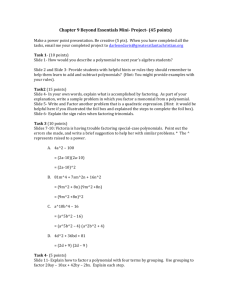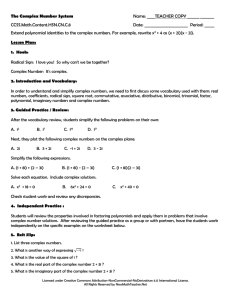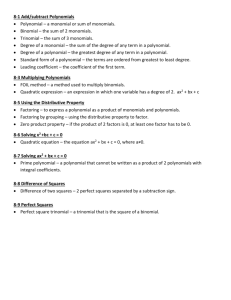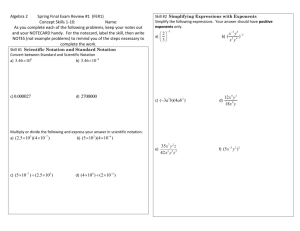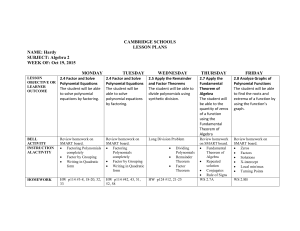Factoring Polynomials: Algebra Essentials
advertisement
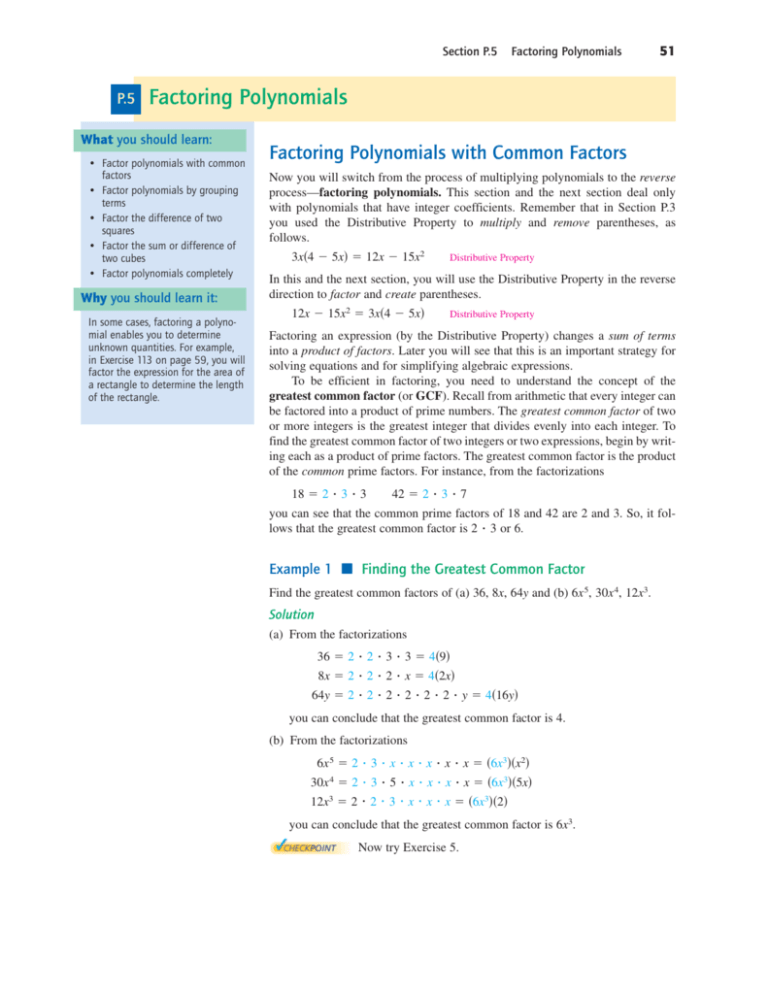
Section P.5 P.5 Factoring Polynomials 51 Factoring Polynomials What you should learn: • Factor polynomials with common factors • Factor polynomials by grouping terms • Factor the difference of two squares • Factor the sum or difference of two cubes • Factor polynomials completely Why you should learn it: In some cases, factoring a polynomial enables you to determine unknown quantities. For example, in Exercise 113 on page 59, you will factor the expression for the area of a rectangle to determine the length of the rectangle. Factoring Polynomials with Common Factors Now you will switch from the process of multiplying polynomials to the reverse process—factoring polynomials. This section and the next section deal only with polynomials that have integer coefficients. Remember that in Section P.3 you used the Distributive Property to multiply and remove parentheses, as follows. 3x4 5x 12x 15x2 Distributive Property In this and the next section, you will use the Distributive Property in the reverse direction to factor and create parentheses. 12x 15x2 3x4 5x Distributive Property Factoring an expression (by the Distributive Property) changes a sum of terms into a product of factors. Later you will see that this is an important strategy for solving equations and for simplifying algebraic expressions. To be efficient in factoring, you need to understand the concept of the greatest common factor (or GCF). Recall from arithmetic that every integer can be factored into a product of prime numbers. The greatest common factor of two or more integers is the greatest integer that divides evenly into each integer. To find the greatest common factor of two integers or two expressions, begin by writing each as a product of prime factors. The greatest common factor is the product of the common prime factors. For instance, from the factorizations 18 2 33 42 2 37 you can see that the common prime factors of 18 and 42 are 2 and 3. So, it follows that the greatest common factor is 2 3 or 6. Example 1 Finding the Greatest Common Factor Find the greatest common factors of (a) 36, 8x, 64y and (b) 6x 5, 30x 4, 12x3. Solution (a) From the factorizations 36 2 2 3 3 49 8x 2 2 2 x 42x 64y 2 2 2 2 2 2 y 416y you can conclude that the greatest common factor is 4. (b) From the factorizations 6x 5 2 3 x x x x x 6x3x2 2 3 5 x x x x 6x35x 12x3 2 2 3 x x x 6x32 30x 4 you can conclude that the greatest common factor is 6x3. Now try Exercise 5. 52 Chapter P Prerequisites Consider the three terms given in Example 1(b) as terms of the polynomial 6x 5 30x 4 12x3. The greatest common factor, 6x3, of these terms is called the greatest common monomial factor of the polynomial. When you use the Distributive Property to remove this factor from each term of the polynomial, you are factoring out the greatest common monomial factor. 6x 5 30x 4 12x3 6x3x2 6x35x 6x32 6x3 x2 5x 2 Factor each term. Factor out common monomial factor. If a polynomial in x (with integer coefficients) has a greatest common monomial factor of the form axn, the statements below must be true. 1. The coefficient a of the greatest common monomial factor must be the greatest integer that divides each of the coefficients in the polynomial. 2. The variable factor xn of the greatest common monomial factor has the lowest power of x of all terms of the polynomial. Example 2 Factoring out a Greatest Common Monomial Factor Factor out the greatest common monomial factor from 24x3 32x2. Solution For the terms 24x3 and 32x2, 8 is the greatest integer factor of 24 and 32 and x2 is the highest-powered variable factor common to x3 and x2. So, the greatest common monomial factor of 24x3 and 32x2 is 8x2. You can factor the given polynomial as follows. 24x3 32x2 8x23x 8x24 8x23x 4 Now try Exercise 19. The greatest common monomial factor of a polynomial is usually considered to have a positive coefficient. However, sometimes it is convenient to factor a negative number out of a polynomial, as shown in the next example. Example 3 A Negative Common Monomial Factor Study Tip Whenever you are factoring a polynomial, remember that you can check your results by multiplying. That is, if you multiply the factors, you should obtain the original polynomial. Factor the polynomial 3x2 12x 18 in two ways. (a) Factor out a 3. (b) Factor out a 3. Solution (a) By factoring out the common monomial factor of 3, you obtain 3x2 12x 18 3x2 34x 36 3 x2 4x 6. Factor each term. Factored form (b) By factoring out the common monomial factor of 3, you obtain 3x2 12x 18 3x2 34x 36 3 x2 4x 6. Now try Exercise 39. Factor each term. Factored form Section P.5 Factoring Polynomials 53 Factoring by Grouping Some polynomials have common factors that are not simple monomials. For instance, the polynomial x22x 3 42x 3 has the common binomial factor 2x 3. Factoring out this common factor produces x22x 3 42x 3 2x 3x2 4. This type of factoring is part of a more general procedure called factoring by grouping. Example 4 A Common Binomial Factor Factor the polynomial 5x26x 5 26x 5. Solution Each of the terms of this polynomial has a binomial factor of 6x 5. Factoring this binomial out of each term produces 5x26x 5 26x 5 6x 55x2 2. Now try Exercise 47. In Example 4, the given polynomial was already grouped, and so it was easy to determine the common binomial factor. In practice, you will have to do the grouping as well as the factoring. To see how this works, consider the expression x3 3x2 5x 15 and try to factor it. Note first that there is no common monomial factor to take out of all four terms. But suppose you group the first two terms together and the last two terms together. Then you have x3 3x2 5x 15 x3 3x2 5x 15 x 3 5x 3 x 3x2 5. x2 Group terms. Factor out common monomial factor in each group. Factor out common binomial factor. Example 5 Factoring by Grouping Factor the polynomial x3 5x2 x 5. Solution x3 5x2 x 5 x3 5x2 x 5 x 5 1x 5 x2 x 5x2 1 Group terms. Factor out common monomial factor in each group. Distributive Property Now try Exercise 53. Note that in Example 5 the polynomial is factored by grouping the first and second terms and the third and fourth terms. You could just as easily have grouped the first and third terms and the second and fourth terms, as follows. x3 5x2 x 5 x3 x 5x2 5 xx2 1 5x2 1 x2 1x 5 54 Chapter P Prerequisites Factoring the Difference of Two Squares Some polynomials have special forms that you should learn to recognize so that they can be factored easily. Here are some examples of forms that you should be able to recognize by the time you have completed this section. x2 9 x 3x 3 x3 8 x 2 x2 Difference of two squares 2x 4 Sum of two cubes x3 1 x 1x2 x 1 Difference of two cubes One of the easiest special polynomial forms to recognize and to factor is the form u2 v2, called a difference of two squares. This form arises from the special product u vu v in Section P.4. Difference of Two Squares Let u and v be real numbers, variables, or algebraic expressions. Then the expression u2 v2 can be factored using the following pattern. u2 v2 u vu v Difference Opposite signs To recognize perfect squares, look for coefficients that are squares of integers and for variables raised to even powers. Here are some examples. Original Polynomial Think: Difference of Squares Factored Form x2 4 x2 22 x 2x 2 4x2 25 2x2 52 25 49x2 52 16y2 4y x10 2x 52x 5 7x 5 7x5 7x 2 x5 2 2 x5 4yx5 4y Example 6 Factoring the Difference of Two Squares Factor (a) x2 64 and (b) 4y2 49. Solution (a) Because x2 and 64 are both perfect squares, you can recognize this polynomial as the difference of two squares. So, the polynomial factors as follows. x2 64 x2 82 x 8x 8 Write as difference of two squares. Factored form 4y2 (b) Because both and 49 are perfect squares, you can recognize the difference of two squares. So, the polynomial factors as follows. 4y2 49 2y2 72 2y 72y 7 Now try Exercise 65. Write as difference of two squares. Factored form Section P.5 Factoring Polynomials 55 Example 7 Factoring the Difference of Two Squares Factor the polynomial 49x2 81y2. Solution Because 49x2 and 81y2 are both perfect squares, you can recognize this polynomial as the difference of two squares. So, the polynomial factors as follows. 49x2 81y2 7x2 9y2 7x 9y7x 9y Write as difference of two squares. Factored form Now try Exercise 71. Remember that the rule u2 v2 u vu v applies to polynomials or expressions in which u and v are themselves expressions. The next example illustrates this possibility. Example 8 Factoring the Difference of Two Squares Factor the difference of two squares. (a) x 22 9 (b) x 52 16 Solution (a) x 22 9 x 22 32 Write as difference of two squares. x 2 3x 2 3 Factored form x 5x 1 Simplify. (b) x 52 16 x 52 42 Write as difference of two squares. x 5 4x 5 4 Factored form x 1x 9 Simplify. To check these results, write the original polynomial in standard form. Then multiply the factored form to see that you obtain the same standard form. Now try Exercise 79. Factoring the Sum or Difference of Two Cubes The last type of special factoring discussed in this section is factoring of the sum or difference of two cubes. The patterns for these two special forms are summarized below. In these patterns, pay particular attention to the signs of the terms. Sum or Difference of Two Cubes Let u and v be real numbers, variables, or algebraic expressions. Then the expressions u3 v3 and u3 v3 can be factored as follows. Like signs Like signs u3 v3 u vu2 uv v2 Unlike signs u3 v3 u vu2 uv v2 Unlike signs 56 Chapter P Prerequisites Example 9 Factoring Sums and Differences of Cubes Study Tip Remember that you can check a factoring result by multiplying. For instance, you can check the first two results in Example 9 as follows. (a) (b) x2 5x 25 x 5 x3 5x2 25x 5x2 25x 125 3 x 125 4y2 2y 1 2y 1 8y3 4y2 2y 4y2 2y 1 8y3 1 Factor each polynomial. (a) x3 125 (b) 8y3 1 (c) 27x3 64y3 Solution (a) This polynomial is the difference of two cubes, because x3 is the cube of x and 125 is the cube of 5. So, you can factor the polynomial as follows. x 5x2 5x 52 Write as difference of two cubes. Factored form x 5x2 5x 25 Simplify. x3 125 x3 53 (b) This polynomial is the sum of two cubes, because 8y3 is the cube of 2y and 1 is its own cube. So, you can factor the polynomial as follows. 2y 12y2 2y1 12 Write as sum of two cubes. Factored form 2y 14y2 2y 1 Simplify. 8y3 1 2y3 13 (c) Because 27x3 is the cube of 3x and 64y3 is the cube of 4y, this polynomial is the difference of two cubes. So, you can factor the polynomial as follows. 27x3 64y3 3x3 4y3 EXPLORATION Find a formula for completely factoring u6 v 6 using the formulas from this section. Use your formula to factor x 6 1 and x 6 64 completely. 3x 4y3x2 3x4y 4y2 Write as difference of two cubes. Factored form 3x 4y9x2 12xy 16y2 Simplify. Now try Exercise 89. Factoring Completely Sometimes the difference of two squares can be hidden by the presence of a common monomial factor. Remember that with all factoring techniques, you should first factor out any common monomial factors. Example 10 Factoring out a Common Monomial Factor First Factor the polynomial 125x2 80 completely. Solution The polynomial 125x2 80 has a common monomial factor of 5. After factoring out this factor, the remaining polynomial is the difference of two squares. 125x2 80 525x2 16 Factor out common monomial factor. 55x 4 Write as difference of two squares. 55x 45x 4 Factored form 2 2 Now try Exercise 95. The polynomial in Example 10 is said to be completely factored because none of its factors can be factored further using integer coefficients. Section P.5 Factoring Polynomials 57 Example 11 Factoring out a Common Monomial Factor First Factor the polynomial 3x 4 81x completely. Solution 3x 4 81x 3xx3 27 3x x3 33 3xx 3x2 3x 9 Factor out common monomial factor. Write as sum of two cubes. Factored form Now try Exercise 97. To factor a polynomial completely, always check to see whether the factors obtained might themselves be factorable. For instance, after factoring the polynomial x 4 16 once as the difference of two squares x 4 16 x22 42 x2 4x2 4 you can see that the second factor is itself the difference of two squares. So, to factor the polynomial completely, you must continue factoring, as follows. x 4 16 x2 4x2 4 x2 4x 2x 2 Example 12 Factoring Completely Study Tip Factor (a) x 4 y 4 and (b) 81m 4 1 completely. Note in Example 12 that the sum of two squares does not factor further. A second-degree polynomial that is the sum of two squares, such as x2 y2 or 9m2 1, is not factorable, which means that it is not factorable using integer coefficients. Solution (a) Recognizing x 4 y 4 as a difference of two squares, you can write x 4 y 4 x22 y22 x2 y2x2 y2. Note that the second factor x2 y2 is itself a difference of two squares and you therefore obtain x 4 y 4 x2 y2x2 y2 x2 y2x yx y. (b) Recognizing 81m 4 1 as a difference of two squares, you can write 81m4 1 9m22 12 9m2 19m2 1. Note that the second factor 9m2 1 is itself a difference of two squares and you therefore obtain 81m4 1 9m2 19m2 1 9m2 13m 13m 1. Now try Exercise 101. Example 13 Using Factoring to Find the Length of a Rectangle The area of a rectangle of width 5x is given by 15x2 40x, as shown in Figure P.15. Factor this expression to determine the length of the rectangle. Length Area = 15x 2 + 40x Figure P.15 5x Solution Factoring out the common monomial factor of 5x from the area polynomial 15x2 40x results in the polynomial 3x 8. So, the length of the rectangle is 3x 8. To check this result, multiply 5x3x 8 to see that you obtain the area polynomial 15x2 40x. Now try Exercise 113. 58 Chapter P Prerequisites Writing About Mathematics Factoring Higher-Degree Polynomials Have each person in your group create a cubic polynomial by multiplying three polynomials of the form x ax ax b. Then write the result in standard form on a piece of paper and describe the steps used to create the polynomials and the steps used to write the polynomial in standard form. Give it to another person in the group to factor. When each person has factored his or her polynomial, compare the results with the original factors used to create the polynomials. P.5 Exercises VOCABULARY CHECK: Fill in the blanks. 1. The ________ of a group of expressions is the product of the common prime factors. 2. In the expression 5x2 10x, 5x is the ________. 3. The process of writing a polynomial as a product is called ________. 4. A polynomial of the form u2 v2 is called a ________ of ________. 5. A polynomial of the form u3 v3 is called a ________ of ________. 6. A polynomial is considered ________ if each of its factors cannot be factored further using integer coefficients. In Exercises 1–12, find the greatest common factor of the expressions. 1. 48, 90 2. 36, 150, 100 2 3. 3x , 12x 5. 30z2, 18x3 6. 45y, 150y3 4. 27x , 12z3 2 4 2 3 2 5 7. 28ab , 14a b , 42a b 2 2 8. 16x y, 84xy , 36x2 2 y 9. 42x 82, 63x 83 11. 4x1 z2, x21 z3 12. 2x 5, 8x 5 15. 18 27. 14x 4 21x3 9x2 28. 25z6 15z4 35z3 29. 17x5y3 xy2 34y2 30. 8y3 6y3z 2y2z2 31. 9x3y 6xy2 32. 24y4z2 12y2z2 33. 3x3y3 34. 18a2b4 2x2 y2 5xy 24a2b2 12a2b 35. 10 5x In Exercises 13–34, factor out the greatest common monomial factor. Some of the polynomials have no common monomial factor other than 1 or 1. 24x2 26. 9 27y 15y2 In Exercises 35–42, factor a negative real number from the polynomial and then write the polynomial factor in standard form. 10. 663 y, 443 y2 13. 8z 8 25. 28x2 16x 8 14. 5x 5 16. 14z3 21 36. 32 4x 37. 7 14x 39. 8 4x 38. 15 5x 2x2 40. 12x 6x2 18 41. 2t 15 4t2 42. 16 32s2 5s4 In Exercises 43–46, fill in the missing factor. 3 5 1 43. 2x 4 4 17. 2x2 x 18. a3 4a 19. 21u2 14u 20. 36y4 24y2 21. 11u2 9 22. 16x2 3y3 5 5 5 45. 6x 9y 18 23. 3x2 y2 15y 24. 4uv 6u2 v2 46. 1 5 1 44. 3x 6 6 7 12 u 7 21 8 v 24 Section P.5 In Exercises 47–52, factor the polynomial by factoring out the common binomial factor. 47. 2y y 3 5 y 3 48. 7ts 9 6s 9 50. 3a t2 a2 3 10 a2 3 51. aa 6 2a 5a 6 95. 50x2 8 96. 3z2 192 97. x3 144x 98. a3 16a In Exercises 53–64, factor the polynomial by grouping. 53. y3 6y2 2y 12 100. a4 625 101. y4 81x4 102. u4 256v 4 103. 2x3 54 104. 5y3 625 105. 52. 5x yx y 5xx y 3a3 192 106. 7b3 56 In Exercises 107 and 108, factor the expression. (Assume n > 0.) 107. 4x2n 25 54. 4x3 2x2 6x 3 59 In Exercises 95–106, factor the polynomial completely. 99. b4 16 49. 5t 1 4 1 t2 Factoring Polynomials 108. 81 16y4n 57. x3 2x2 x 2 In Exercises 109 and 110, show all the different groupings that can be used to factor the polynomial completely. Carry out the various factorizations to show that they yield the same result. 58. t3 11t2 t 11 109. 3x3 4x2 3x 4 55. 14z3 21z2 6z 9 56. 7t3 5t2 35t 25 59. a3 4a2 2a 8 110. 6x3 8x2 9x 12 60. 3s3 6s2 5s 10 111. Simple Interest The total amount of money from a principal of P invested at r% simple interest for t years is given by P Prt. Factor this expression. 61. z4 3z3 2z 6 62. 4u4 2u3 6u 3 112. Revenue The revenue from selling x units of a product at a price of p dollars per unit is given by xp. For a particular commodity, the revenue R is 63. cd 3c 3d 9 64. u2 uv 4u 4v In Exercises 65–82, factor the difference of two squares. 65. x2 25 66. y2 144 67. 100 9y2 68. 625 49x2 69. 121 y2 70. 81 z2 71. 16y2 9z2 72. 9z2 25w2 73. x2 4y2 74. 81a2 b6 36 75. a8 77. a2b2 16 76. y10 64 78. u2v2 25 79. a 42 49 80. x 32 4 81. 81 z 52 82. 100 y 32 In Exercises 83–94, factor the sum or difference of two cubes. 83. x3 8 84. t3 27 85. y3 125 86. z3 216 87. 8t3 27 88. 64a3 1 89. 27s3 64 90. 125x3 343 91. 8x3 y3 92. a3 216b3 93. y3 64z3 94. z3 125w3 R 800x 0.25x2. Factor the expression for the revenue and determine an expression for the price in terms of x. 113. Geometry A rectangle has area and width as indicated in the figure. Factor the expression for area to find the length of the rectangle. A = w 2 + 8w w A = 27t 2 − 18t ? 9t ? Figure for 113 Figure for 114 114. Geometry A rectangle has area and length as indicated in the figure. Find the width of the rectangle. 115. Geometry The area of a rectangle of width w is given by 32w w2. Factor this expression to determine the length of the rectangle. Draw a diagram to illustrate your answer. 116. Geometry The area of a rectangle of length l is given by 45l l 2. Factor this expression to determine the width of the rectangle. Draw a diagram to illustrate your answer. 60 Chapter P Prerequisites 117. Geometry The area of a rectangle of width 2x2 is given by 10x3 4x2. Factor this expression to determine the length of the rectangle. Draw a diagram to illustrate your answer. 118. Geometry The area of a rectangle of length y 5 is given by 3y2 15y. Factor this expression to determine the width of the rectangle. Draw a diagram to illustrate your answer. 119. Geometry The surface area S of a right circular cylinder is S 2r 2 2 rh (see figure). Factor the expression for the surface area. r h 120. Manufacturing A washer on the drive train of a car has an inside radius of r centimeters and an outside radius of R centimeters (see figure). Find the area of one of the flat surfaces of the washer and write the area in factored form. r R Writing In Exercises 125 and 126, explain how the product could be obtained mentally using the sample as a model. 48 52 50 250 2 502 22 2496 125. 79 126. 18 81 6399 22 396 127. Exploration The cube shown in the figure is formed by four solids: I, II, III, and IV. (a) Explain how you could determine each expression for volume. Entire cube Solid I Solid II Solid III Solid IV 122. Writing Explain the relationship between using the Distributive Property to multiply polynomials and using the Distributive Property to factor algebraic expressions. 123. Writing Explain what is meant when it is said that a polynomial is in factored form. 124. Writing Explain how the word factor can be used as a noun and as a verb. b3 (b) Add the volumes of solids I, II, and III. Factor the result to show that the total volume can be written as a ba2 ab b2. (c) Explain why the total volume of solids I, II, and III can also be written as a3 b3. Then explain how the figure can be used as a geometric model for the difference of two cubes factoring pattern. 121. Chemistry The rate of change of an autocatalytic chemical reaction is kQx kx2, where Q is the amount of the original substance, x is the amount of substance formed, and k is a constant of proportionality. Factor the expression for this rate of change. Synthesis Volume a3 a ba2 a bab a bb2 a a I a−b II a IV III b a−b b a−b b

